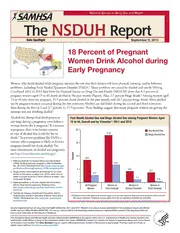
NSDUH Report: 2013: Data Spotlight: 18% of Pregnant Women Drink Alcohol During Early Prenancy, The PDF
Preview NSDUH Report: 2013: Data Spotlight: 18% of Pregnant Women Drink Alcohol During Early Prenancy, The
National Survey on Drug Use and Health NSDUH The Report Data Spotlight September 9, 2013 18 Percent of Pregnant VA60 Women Drink Alcohol during Early Pregnancy Women who drink alcohol while pregnant increase the risk that their infants will have physical, learning, and/or behavior problems, including Fetal Alcohol Spectrum Disorder (FASD).1 These problems are caused by alcohol and can be lifelong. Combined 2011 to 2012 data from the National Survey on Drug Use and Health (NSDUH) show that 8.5 percent of pregnant women aged 15 to 44 drank alcohol in the past month (Figure). Also, 2.7 percent binge drank.2 Among women aged 15 to 44 who were not pregnant, 55.5 percent drank alcohol in the past month, and 24.7 percent binge drank. Most alcohol use by pregnant women occurred during the first trimester. Alcohol use was lower during the second and third trimesters than during the first (4.2 and 3.7 percent vs. 17.9 percent). These findings suggest that many pregnant women are getting the message and not drinking alcohol. Alcohol can disrupt fetal development at Past Month Alcohol Use and Binge Alcohol Use among Pregnant Women Aged any stage during a pregnancy, even before a 15 to 44, Overall and by Trimester*: 2011 and 2012 woman knows she is pregnant.3 If a woman is pregnant, there is no known amount 20 Any Alcohol Use or type of alcohol that is safe for her to 17.9 Binge Alcohol Use drink.4 To prevent problems like FASD, a woman who is pregnant or likely to become 15 pregnant should not drink alcohol. For more information on alcohol and pregnancy, see http://www.fascenter.samhsa.gov/. nt ce 10 er 8.5 P 1. National Institute on Alcohol Abuse and Alcoholism. (1996). Drinking and your pregnancy (NIH Publication 6.6 No. 96–4101). Retrieved from http://pubs.niaaa.nih.gov/ publications/DrinkingPregnancy_HTML/pregnancy.htm 5 4.2 3.7 2. Binge alcohol use is defined as drinking five or more 2.7 drinks on the same occasion (i.e., at the same time or within a couple of hours of each other) on at least 1 day 1.1 in the past 30 days. 0.4 3. National Institute on Alcohol Abuse and Alcoholism. 0 (2012). Fetal alcohol exposure. Retrieved from All Pregnant Women in Women in Women in http://www.niaaa.nih.gov/alcohol-health/fetal-alcohol- Women First Trimester Second Trimester Third Trimester exposure 4. Centers for Disease Control and Prevention. (2011). Fetal alcohol spectrum disorders (FASDs): Facts about * Pregnant women are defined as women aged 15 to 44 who reported that they were pregnant at the time of FASDs. Retrieved from http://www.cdc.gov/ncbddd/ the survey interview. Pregnant women aged 15 to 44 not reporting trimester are excluded. fasd/facts.html Source: National Surveys on Drug Use and Health (NSDUHs), 2011 and 2012. NSDUH is an annual survey sponsored by the Substance Abuse and Mental Health Services Administration (SAMHSA). The survey collects data by administering questionnaires to a representative sample of the population through face-to-face interviews at their places of residence. The Substance Abuse and Mental Health Services Administration (SAMHSA) is the agency within the U.S. Department of Health and Human Services that leads public health efforts to advance the behavioral health of the nation. SAMHSA’s mission is to reduce the impact of substance abuse and mental illness on America’s communities. The Data Spotlight may be copied without permission. Citation of the source is appreciated. Find this report and those on similar topics online at http://www.samhsa.gov/data/.
